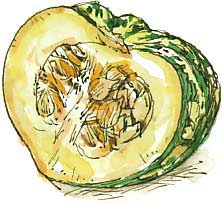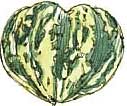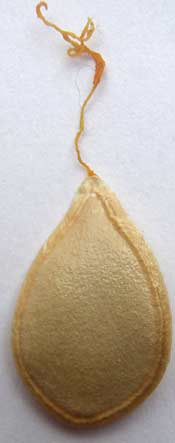
 Sweet Dumpling
Sweet Dumpling
 Sweet Dumpling
Sweet DumplingWild West Yorkshire, Friday 15 October 2010
previous | this month | next
THE SWEET DUMPLING is a variety of winter squash which grows just 4 inches, 10 cm, across. The wild winter squash, Cucurbita maxima, originated in South America. It is also known as autumn squash or winter pumpkin. Butternut, turban and banana squashes are varieties of the same species.
 We used this in roast veg with carrot, parsnip and potato but you could also stuff the scooped out halves with mince and rice and roast them.
We used this in roast veg with carrot, parsnip and potato but you could also stuff the scooped out halves with mince and rice and roast them.
 When drawing the seeds, I realised how similar they are to the pumpkin seeds you'd buy in a health food shop which are rich in phosphorus, magnesium, manganese and other minerals and which contain vitamin K. I rinsed and patted the seeds dry with a tea towel then fried them until golden and slightly toasted in sunflower oil. Warning; they make popping noises in the pan! I put them on kitchen towel to absorb any surplus oil.
When drawing the seeds, I realised how similar they are to the pumpkin seeds you'd buy in a health food shop which are rich in phosphorus, magnesium, manganese and other minerals and which contain vitamin K. I rinsed and patted the seeds dry with a tea towel then fried them until golden and slightly toasted in sunflower oil. Warning; they make popping noises in the pan! I put them on kitchen towel to absorb any surplus oil.
They had that same sort of toasty taste you'd get with pumpkin seeds or pine nuts and they added a crunchy texture to a watercress salad.
I noticed that several of the seeds still had their pollen tubes attached (right) and, at the top, what I'm guessing is the stigma. Having hitched a ride on any passing insect that was vistiting the showy yellow flowers of the squash, the male gametes (sex cells) have to make their way down this tube to fertilise the female gamete; the ovum. I think of plants as being static but these male gametes have to be surprisingly active.
The outer case of the seed is the testa (seed coat) and, as well as protecting the cotyledon (seed leaf of the embryo plant) it also encloses the endosperm, which is the food store for the plant.
The botanical name for the fruit of the squash is a pepo - a type of berry.
I've kept a few of the seeds which I'm going to try sowing in a pot of compost - not that I'm going to try and grow a squash at this time of year but I'm curious to see if the seeds are viable and what the plants will look like.
Richard Bell, illustrator
previous | this month | Wild West Yorkshire home page | next